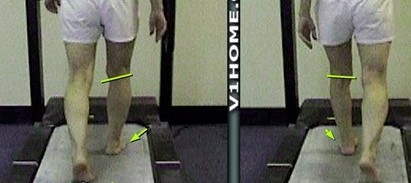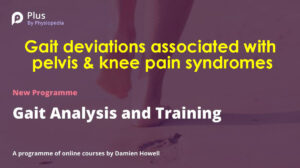Gait Deviation – Excessive Inward Rotation of Hip Joint

Excessive inward rotation of the hip joint can be a contributing factor to development of repetitive use injuries of:
- Lateral hip pain (gluteal muscle tendinopathy)
- Buttock pain (piriformis syndrome)
- Anterior knee pain (patella femoral arthralgia)
- Lateral knee pain (IT band syndrome
- Shin pain (posterior tibial tendinopathy)
- Plantar heel pain
This video first illustrates the gait deviation of excessive inward rotation of the left hip, then it illustrates a conscious alteration of the gait deviation.
Notice the first half of the video the skin crease on the back of the knee. The right knee the skin crease is horizontal or parallel to the ground. Whereas the skin crease on the back of the left knee is not horizontal or parallel to ground. Notice the right knee the medial and lateral hamstring tendons appear equal distance to the camera. Whereas on the left knee the medial hamstring tendons appear farther from the camera and the lateral hamstring tendons appear to be closer to the camera.
Also notice the first half of the video the left big toe is visible, whereas the right big toe is not. This is another sign of excessive inward rotation of the left leg.
The left hip joint or thigh bone in rotating inward too much.
In the second half of the video the subject was instructed to consciously alter her gait to image the left knee cap is pointing straight ahead and engage your left buttock muscle.
Excessive inward rotation of hip joint can occur as a result of acquired muscular imbalance. This can be altered and possibly eliminated.
Excessive inward rotation of the hip joint can occur as a result of pre-existing anatomical structural boney variations of the hip joint (pelvic anti-version, femoral torsion). In this case it is unwise to try to alter this gait deviation. In this case the hip joint came to the world with a structural variation. A physical therapist can help determine whether the gait deviation should be altered or allowed to continue.
A on demand-video webinar exploring this topic is available at Plus by Physiopedia entitled “Gait deviations associated with pelvis & knee pain syndromes”
Use this code – “Damien25” for a 30% discount to access this webinar as well as the more than 500 continuing education webinar courses available at Plus by Physiopedia. This is the link http://bit.ly/DAMIEN25 with the 30% discount code embedded.
Damien Howell Physical Therapy – 804-647-9499 – Fax: 866-879-8591 At-Home, At Office, At Fitness Facility – I come to you, I do home visits Damien@damienhowellpt.com

